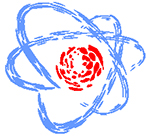Speaker
Mr
majed Abdel Salam Abdel Ghani
(Cairo-University - Lecture assistant)
Description
A fascinating quantum tunneling effect was postulated by Brain Josephson in 1962, in which a supercurrent tunnels through an insulator between two superconductor electrodes. In strongly anisotropic layered high temperature superconductors (HTSC), these superconducting layers together with intermediate dielectric layers form the system of coupled Josephson junctions and thus, the intrinsic Josephson effect occurs. If spin-polarized quasiparticles injected into superconducting materials, this may lead to new types of device functionality based on spintronics. This can be done by considering superconductor/ferromagnetic/superconductor (S/F/S) Josephson junctions where the spin-orbit interaction in a ferromagnetic without inversion symmetry provides a mechanism for a direct coupling between the magnetic moment and the superconducting current.
In this study, we consider superconductor ferromagnetic junction under RF-magnetic field in xy-plane. In ferromagnetic, the order parameter is the magnetization and its collective modes are spin wave. These modes can be excited using microwave magnetic field. The energy level in ferromagnet is zemman splitting. A resonance occurs if the energy from an oscillating magnetic field is absorbed at frequency corresponding to transitions between the splinting energy states. In superconductor the order parameter is the condensate, which has phase and current that is generated from the dynamics of the phase. We studied the effect of spin dynamics on Josephson phase dynamics by solving numerically system of nonlinear equations that combine the modified RSJ model with Landau Lifshitz-Gilbert equation.
Authors
Prof.
Yury Madzhnunovich Shukrinov
(JINR-BLTP lab)
Mr
majed Abdel Salam Abdel Ghani
(Cairo-University - Lecture assistant)
Co-authors
Dr
Ali Elilthi
(Cairo University)
Prof.
Tharwat El Sherbini
(Cairo-University)

